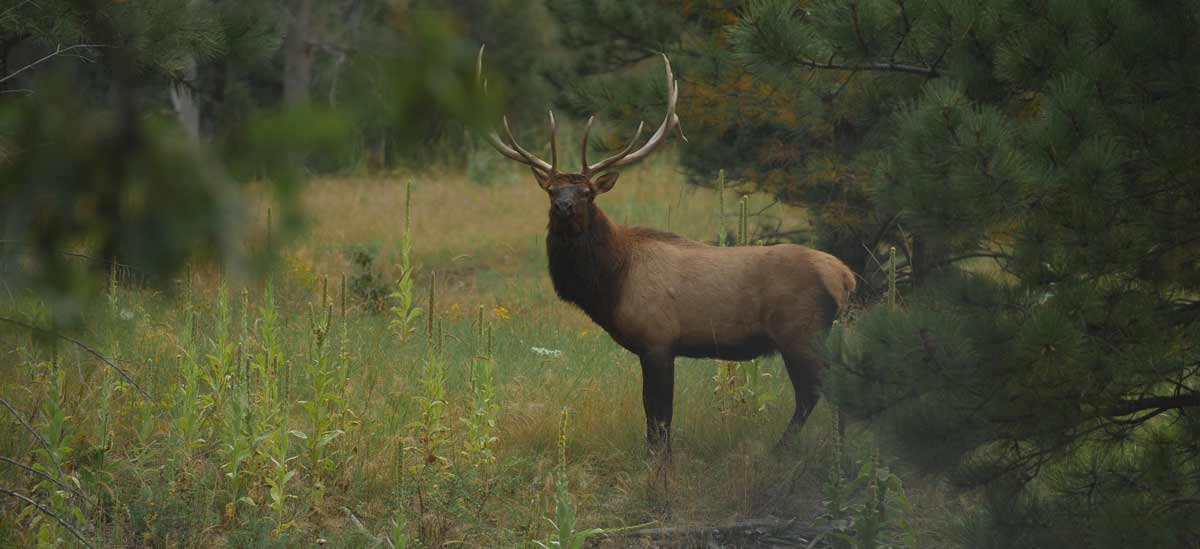Animal vision expert Dr. Jay Neitz has spent more than 20 years studying how ungulates see the world. “Ultimately, what we know about animal vision,” explains Dr. Neitz, “really has opened a whole new world of understanding things about human vision.”
One of the most basic distinctions between the way an ungulate sees and a human sees is the placement of their eyes. Since ungulates’ eyes are on the sides of their heads, they have a much larger field of view (280 degrees); whereas a human’s field of view is about 180 degrees. An elk only has to turn its head slightly side to side and it can see a full 360 degrees.
Human vision is most acute in the center of the eye, allowing people to focus intently on details directly in front of the face. Deer and elk excel at seeing the big picture. “ have a visual streak,” says Dr. Neitz. “They have their best vision right along the horizon, where their predators come from. They don’t really need to look up at the sky because the hawks aren’t going to eat them.”
In exchange for having a wider field of view, ungulates have reduced visual acuity, equal to about 20/40. However, that doesn’t mean their vision is worse than a human’s. Dr. Neitz explains this difference in terms of a digital picture: “Ungulates’ lower visual acuity doesn’t mean things aren’t in focus. They’re just sampling information with a lower density of detectors. It’s like the resolution of a digital picture in megapixels; deer are analyzing more visual area at fewer megapixels.”
Another key factor in how ungulates see is based on their color vision. Humans are trichromats; they see red, yellow and blue (as well as black, white and shades of gray). Ungulates have dichromatic vision; they only see yellow and blue (along with black, white and shades of grey). But your blaze orange vest works because it is not blaze orange to ungulates. It’s merely a shade of gray—but a big blob of gray. Some blaze orange vests are broken-up by vegetation patterns. However, ungulates can see the blue end of the spectrum 1,000x times brighter than a human can, which is why they pick up Ultraviolet light (UV) so easily and why some hunters take great care not to wash their camouflage apparel in detergents that contain UV brighteners.
Ungulates are also more sensitive to changes in coarser patterns in the environment than a human, which is why they can easily pick up an encroaching predator on the horizon. Humans would nearly have to be looking directly at something sneaking up on them for it to be noticed. “We’re really tuned into fine patterns like you would find with the lines on a topo map,” Dr. Neitz explains. “You couldn’t show a topo map to a deer. They wouldn’t find it very interesting.”
Dr. Neitz likes to use Salvador Dali’s 1976 painting, Gala Contemplating the Mediterranean Sea, to illustrate. The famous painting actually contains two images. The obvious image is of Dali’s subject, Gala, standing in the nude looking out a window. But when the painting is viewed at a distance of more than 30 meters, it becomes a portrait of Abraham Lincoln. In terms of animal vision, humans see the naked woman and elk see Abraham Lincoln.
“You could make a camouflage pattern for a human where our eye could pull out all the fine detail you put into the pattern,” says Dr. Neitz, “but you could miss the coarse detail that’s going to produce the camouflage effect for the deer’s eye.” Getting the right pattern down for hunting purposes has been a long-sought goal for camouflage producers.
